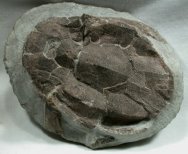Bothriolepis canadensi
Infraphylum Gnathostomata, Class Placodermi, Order Antiarcha, Family Bothriolepidae
Geologic Time: Upper Devonian
Size: 108 mm in length
Fossil Site: Escumiac Bay, Miguasha, Quebec, Canada
 Bothriolepis
is one
of the most widely-recognized of all the ancient Armoured fishes. The
box-like body was enclosed in armor plates, and provided Armoured Fossil
Fishprotection from predators. Bothriolepis
was the most successful of all the placoderms, with some 100 species
known from every continent, including Antarctica. The paired holes housed
both the eyes and the nostrils. Some specimens have been sectioned to
show the paired lung-like organs and spiral intestine, giving a detailed
view of this interesting fish. It had a long pair of pectoral fins which
would have helped to lift it from the bottom; its heavy body would have
sunk quickly back to the bottom as soon as forward momentum was lost.
The Armoured Fossil Fishfins possessed spines (see the closeup), and
an articulation to the boxlike trunk. It is thought that Bothriolepis
grubbed in the mud of its freshwater home, and may also have used its
pectorals to stir up the mud that provided its food. This is a well preserved
example of the trunk, the only part preserved with any degree of frequency,
and shows the pectorals as well
Bothriolepis
is one
of the most widely-recognized of all the ancient Armoured fishes. The
box-like body was enclosed in armor plates, and provided Armoured Fossil
Fishprotection from predators. Bothriolepis
was the most successful of all the placoderms, with some 100 species
known from every continent, including Antarctica. The paired holes housed
both the eyes and the nostrils. Some specimens have been sectioned to
show the paired lung-like organs and spiral intestine, giving a detailed
view of this interesting fish. It had a long pair of pectoral fins which
would have helped to lift it from the bottom; its heavy body would have
sunk quickly back to the bottom as soon as forward momentum was lost.
The Armoured Fossil Fishfins possessed spines (see the closeup), and
an articulation to the boxlike trunk. It is thought that Bothriolepis
grubbed in the mud of its freshwater home, and may also have used its
pectorals to stir up the mud that provided its food. This is a well preserved
example of the trunk, the only part preserved with any degree of frequency,
and shows the pectorals as well
RGP111106
Virtual
Fossil Museum Also see: Class Placodermi